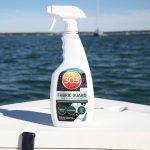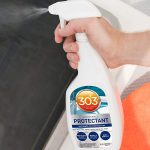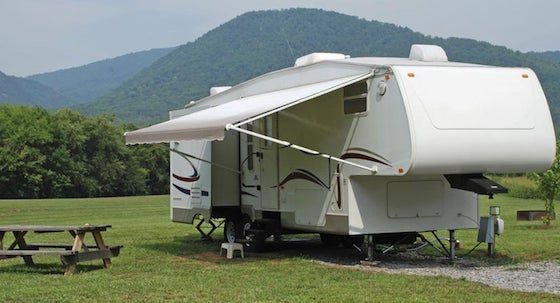Thanks for your support! If you make a purchase using our links in this article, we may make a commission. And, as an Amazon Associate, I earn from qualifying purchases. See the full disclosure here.
Homemade RV Awning Cleaner and Cleaning Tips
Any RVer will roll their eyes when the conversation arises on keeping an awning clean. And there are many homemade RV awning cleaning solutions that have been used. But not all homemade awning cleaners are created equal. Getting your RV awning squeaky clean with the proper cleaning agent depends on the material of that particular awning. Many RV awnings are made from a premium “marine-grade” vinyl, while fabric awnings are most likely a dyed acrylic fabric.
Read on to get cleaning tips for both types. Mold and mildew seem to appear overnight before your very eyes. Depending on the color of your awning, it may show up as a big, green, moldy flag to you and everyone else near your campsite. Fear not, with a little diligent TLC, you can extend the life of your awning and have it looking like new again.
Fabric Awnings
Fabric awnings are commonly referred to as acrylic or canvas and are often made by Sunbrella. They are breathable, UV resistant and dry quickly. Fabric awnings are not waterproof but are water repellant. The repellant finish, however, can fade and lose its repellency over time. When this happens, you’ll notice the awning stays damp, and it may even begin to leak. Be sure to reapply a water repellant like 303 Fabric Guard to fabric awnings as needed. Without proper treatment, the awning could permanently stain.
Vinyl Awnings
Vinyl awnings are mildew resistant but not mildew proof. In humid and rainy climates, this can be particularly troublesome as the awning remains wet much of the time. When vinyl is treated properly with a quality protectant like 303 Aerospace Protectant, mold and mildew can be kept at bay.
Prepare To Clean Your RV Awning
If you read many articles or forums online on the subject of cleaning an awning, you’ll find that everyone has their “tried and true” method guaranteed to work. And, of course, you’re left wondering, will this really work? The last thing you want to do is damage your awning or shorten its lifespan. With that said, there are several methods and cleaners that work well. Whether fabric or vinyl, getting ready to clean your awning will involve wearing clothes that you don’t mind getting dirty or stained. Also, be sure to put on a protective face mask and gloves. Cleaning products, as well as mold spores, can easily be inhaled or get in your eyes causing irritation or illness.
You’ll need a long-handled push-style broom and a hand brush or sponge. A push broom should be long enough to reach across the top of your awning. The hand brush should be soft for vinyl awnings. Using a hard or course brush can be detrimental to the repellant that keeps the vinyl mildew resistant. A sponge or soft cloth can be used on fabric awnings but keep in mind never scrub so hard as to damage or tear the fabric. A step ladder may come in handy for ensuring you can reach all areas and corners of the awning. You’ll need a hose and spray nozzle for wetting down the awning and rinsing, as well as a spray bottle or bucket to hold your cleaner.
How to Make Homemade RV Awning Cleaner
Here’s where the fun begins. Choosing your awning cleaner is a bit like “choosing your poison.” Remember, I mentioned earlier there are opinions galore on tried and true methods. These homemade cleaners have been touted to work wonders.
DIY Recipe #1: Mix one-gallon water and one quart of white vinegar (approved for vinyl or fabric).
DIY Recipe #2: Same as Recipe #1 but add one squeeze of Dawn dish soap (approved for vinyl or fabric).
DIY Recipe #3: Mix one part hydrogen peroxide to six parts water. (This is best used on vinyl as opposed to fabric awnings.)
DIY Recipe #4: Mix two parts grated Fels-Naptha bar soap, one-part borax (sodium borate), one-part washing soda (sodium carbonate) and hot water. Adjust your mixture to what works best for the size of your awning. Consistency should be a semi-liquid soap when cool. The leftover solution can be stored for future use (approved for vinyl or fabric).
DIY Recipe #5: This recipe is especially for fabric awnings. Mix baking soda with a small amount of water to form a paste. Gently rub soiled areas with a sponge. Baking soda cleans and refreshes without harming the fabric and rinses clean.
While several RVers have admitted to using bleach, granted a relatively small amount in comparison to the amount of water, bleach can only be used sparingly and no more than once a year. It is detrimental to vinyl stitching and discolors fabric. If you do use bleach, test an inconspicuous spot first to see if fading or discoloration occurs.
While these next two are not “homemade” products, I found Spic N Span and “Awesome” Cleaner mentioned several times as great cleaning agents. With any over the counter products not specifically made for RV awnings, its best to read the ingredient label and again, do a test spot.
Tips for Cleaning Your RV Awning
Now that you’ve decided upon your cleaner, there’s a method to this madness. Application and timing are everything.
Step 1: Extend the awning. Inspect the bottom awning brackets, lag bolts, pivot holes and rivets for any needed repair. Ensure the top rail of the awning is securely mounted to the side of the RV. Never remove the awning end caps. Serious injury may occur from spring tension.
Step 2: Thoroughly wet the extended and stabilized awning top and underside.
Step 3: Apply the cleaner with either a spray bottle or by dipping a brush into a bucket of the cleaner. Use a long-handled brush to rub the cleaner onto the awning ensuring all areas are covered top and underside. Take time to gently scrub the stained areas with a hand brush or sponge. Toothbrushes make a perfect cleaning tool for corners and crevices.
Step 4: Roll up or retract the awning. Let sit for 15 to 30 minutes. Some RV owners have suggested waiting only 5 minutes while others believe a full 30 minutes works best. You’ll need to be the judge on this one.
Step 5: At this point, dip one corner of the awning downward for easy run-off. Rinse thoroughly with a hose.
If you are seeing any bubbles or residue, an additional rinse certainly will do no harm. Leave the awning out until completely and thoroughly dry. Know your limitations. This can be a physically demanding job, and an awning may need hours of attention if it’s dirtier than imagined. Sometimes it’s best to have a professional do the job. “For heavier jobs or on hard to reach awnings, the best step is to call a professional who will attack the problem with a pressurized water cleaner that flushes dirt and grime away,” says Jeff Bredenberg in Clean It Fast, Clean It Right: The Ultimate Guide to Making Absolutely Everything You Own Sparkle & Shine.
Protecting Your RV Awning
Now that you’ve gone through the effort to get that awning mold and mildew-free applying a protective shield will do wonders to enhance the mildew and water-resistant qualities of your awning. Depending on the material, vinyl or fabric, there are several good repellants on the market. We really like the 303 products because they seem to work the best. Be sure to follow use directions for application of any products purchased.
 303 Fabric Guard – This commercial-grade protector guarantees the best shield for your fabric awning against the outdoor elements. Many consumer-grade protectors do not do an adequate job with fabric awnings. Use this product on Fabric Awnings after a good cleaning. It will help to keep your awning looking great while repelling water.
303 Fabric Guard – This commercial-grade protector guarantees the best shield for your fabric awning against the outdoor elements. Many consumer-grade protectors do not do an adequate job with fabric awnings. Use this product on Fabric Awnings after a good cleaning. It will help to keep your awning looking great while repelling water. 
303 Aerospace Protectant – This high-quality treatment for vinyl awnings not only protects against fading and the sun’s UV rays but repels dust and stains too. This protectant also restores the color of the awning and helps it resist cracking. Look for a spray that is soil resistant, water and stain repellant and long-lasting. Silicone or oil-based sprays should never be used on fabric awnings.
RELATED READING: Check out our article called How to Clean the Outside of a Camper Trailer for a ton of cleaning tips and products to clean the outside of your RV!
Happy Awning = Happy Campers. With a little ingenuity, elbow grease, and know-how you can keep your RV awning in tip-top shape, giving it a long life and an attractive appearance. You’ll be one happy camper rolling out that beautiful awning at your campsite now!
Do you have any helpful tips or advice for cleaning an RV awning? Please share your ideas or comments below? And if you found this article to be informative please help us out and share it on social media! We really appreciate you taking a second to share our content!



Thanks for all the tips just purchased my first RV. I plan on using your cleaning recipe and have been reading up on the 303 protectant.
Hi Aimee,
Glad you like the tips and good luck with your new RV!
Mike
Mike and Susan your blog is extremely Fabulous and informative for us. The article about Homemade RV Awning Cleaner is good.
Thanks Peter!
Glad you liked the article!
Mike
Thank you for explaining that when you clean an awning, you will need a push broom and a sponge. My sister is planning on getting an awning for her RV soon, but I don’t think she knows how to clean it. I will be sure to forward this article to her so that she can know what to do with it.
Hi Sandra,
Thanks for reading the article and commenting! I think you are our number one fan!
Mike